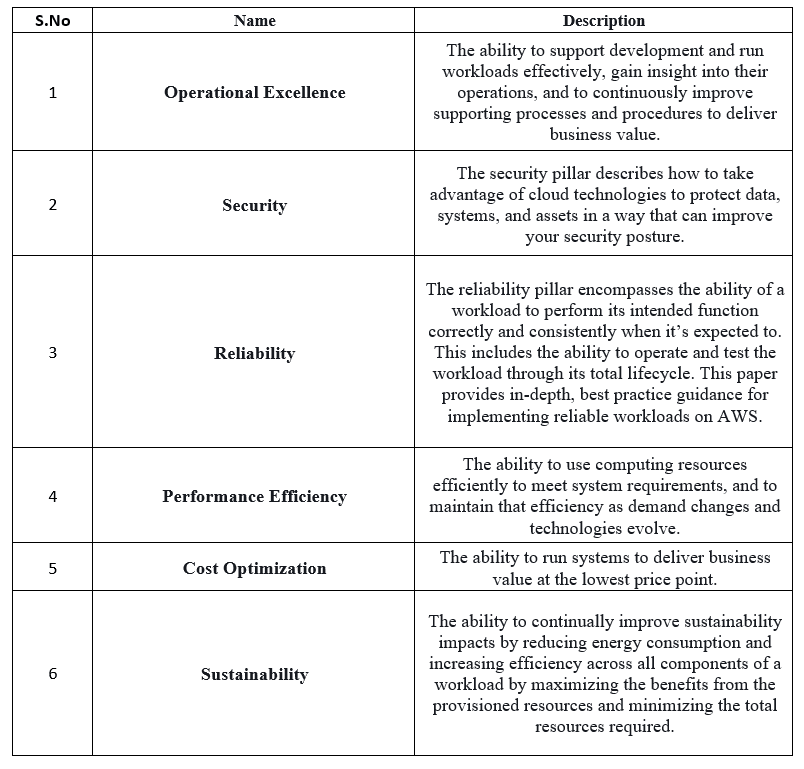AWS Cloud Services - Pillars of AWS Well-Architected Framework
What is Cloud Architecture
Cloud architecture is the practice of applying cloud characteristics to a solution that uses cloud services and features to meet an organization’s technical needs and business use cases. A solution is similar to a blueprint for a building.
We can use AWS services to create highly available, scalable, and reliable architectures
Software systems require architects to manage their size and complexity.
Cloud architects
• Engage with decision makers to identify the business goals and the capabilities that need improvement.
• Ensure alignment between technology deliverables of a solution and the business goals.
• Work with delivery teams that are implementing the solution to ensure that the technology features are appropriate.
Having well-architected systems increases the likelihood that the technology deliverables will help meet business goals.
AWS Well-Architected Framework
The AWS Well-Architected Framework provides a consistent approach to evaluate cloud architectures and guidance to help implement designs.
It is based on six pillars - operational excellence, security, reliability, performance efficiency, cost optimization, and sustainability.
The pillars of the AWS Well-Architected Framework
Operational Excellence
The Operational Excellence pillar addresses the ability to run systems and gain insight into their operations to deliver business value. It also addresses the ability to continuously improve supporting processes and procedures.
When we design a workload for operations, we must be aware of how it will be deployed, updated, and operated. Implement engineering practices that align with defect reductions and quick, safe fixes. Enable observation with logging, instrumentation, and business and technical metrics so that you can gain insight into what is happening inside your architecture.
In AWS, we can view our entire workload (applications, infrastructure, policy, governance, and operations) as code. It can all be defined in and updated using code. This means that we can apply the same engineering discipline that we use for application code to every element of our stack.
Security
The Security pillar addresses the ability to protect information, systems, and assets while delivering business value through risk assessments and mitigation strategies.
Our architecture will present a much stronger security presence if we implement
a strong identity foundation, enable traceability, apply security at all layers, automate security best practices, and protect data in transit and at rest.
Reliability
The Reliability pillar addresses the ability of a system to recover from infrastructure or service disruptions and dynamically acquire computing resources to meet demand. It also addresses the ability of a system to mitigate disruptions such as misconfigurations or transient network issues. It can be difficult to ensure reliability in a traditional environment. Issues arise from single points of failure, lack of automation, and lack of elasticity. By applying the best practices outlined in the Reliability pillar, we can prevent many of these issues. It will help us and our customers to have a properly designed architecture with respect to high availability, fault tolerance, and overall redundancy.
Performance efficiency
- choose efficient resources and maintain their efficiency ad demand changes
- Democratize advanced technologies
- Employ mechanical sympathy.
Cost Optimization
Cost optimization is an ongoing requirement of any good architectural design. The process is iterative, and it should be refined and improved throughout our production lifetime. Understand how efficient our current architecture is in relation to our goals can remove unneeded expense. We can consider using managed services because they operate at cloud scale, and they can offer a lower cost per transaction or service.
Sustainability
The Sustainability pillar focuses on environmental impacts, especially energy consumption and efficiency, since they are important levers for architects to inform direct action to reduce resource usage.
The AWS Well-Architected Tool
The AWS Well-Architected Tool is a self-service tool that provides us with on-demand access to current AWS best practices. These best practices can help us build secure, high-performing, resilient, and efficient application infrastructure on AWS.
It helps us review the state of our workloads and compares them to the latest AWS architectural best practices.
This tool is available in the AWS Management Console. We can define our workload and answer a series of questions in the areas of operational excellence, security, reliability, performance efficiency, and cost optimization. The AWS Well-Architected Tool then delivers an action plan with step-by-step guidance on how to improve our workload for the cloud.
We can use the results that the tool provides to identify next steps for improvement, drive architectural decisions, and bring architecture considerations into our corporate governance process.
References :
https://www.wellarchitectedlabs.com/operational-excellence/
https://www.wellarchitectedlabs.com/security/
https://www.wellarchitectedlabs.com/reliability/
https://www.wellarchitectedlabs.com/performance-efficiency/
https://www.wellarchitectedlabs.com/cost/
https://www.wellarchitectedlabs.com/sustainability/
https://www.wellarchitectedlabs.com/well-architectedtool/
Social Footprints :
Happy Learning 📚
Thank you!







Top comments (0)